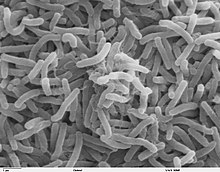| Vibrio cholerae | |
|---|---|

| |
| Scientific classification | |
| Domain: | Bacteria |
| Phylum: | Pseudomonadota |
| Class: | Gammaproteobacteria |
| Order: | Vibrionales |
| Family: | Vibrionaceae |
| Genus: | Vibrio |
| Species: | V. cholerae
|
| Binomial name | |
| Vibrio cholerae Pacini, 1854
| |
Vibrio cholerae is a species of Gram-negative, facultative anaerobe and comma-shaped bacteria.[1] The bacteria naturally live in brackish or saltwater where they attach themselves easily to the chitin-containing shells of crabs, shrimp, and other shellfish. Some strains of V. cholerae are pathogenic to humans and cause a deadly disease called cholera, which can be derived from the consumption of undercooked or raw marine life species or drinking contaminated water.[2]
V. cholerae was first described by Félix-Archimède Pouchet in 1849 as some kind of protozoa. Filippo Pacini correctly identified it as a bacterium and from him, the scientific name is adopted. The bacterium as the cause of cholera was discovered by Robert Koch in 1884. Sambhu Nath De isolated the cholera toxin and demonstrated the toxin as the cause of cholera in 1959.
The bacterium has a flagellum (a tail like structure) at one pole and several pili throughout its cell surface. It undergoes respiratory and fermentative metabolism. Two serogroups called O1[3] and O139[4] are responsible for cholera outbreaks. Infection is mainly through drinking contaminated water or ingestion of food contaminated with faecal matter from an infected person, therefore is linked to sanitation and hygiene. When ingested, it invades the intestinal mucosa which can cause diarrhea and vomiting in a host within several hours to 2–3 days of ingestion. Ringers lactate and Oral rehydration solution combined with antibiotics such as fluoroquinolones and tetracyclines are the common treatment methods in severe cases.
V. cholerae has two circular chromosomes. One chromosomes produces the cholera toxin (CT), a protein that causes profuse, watery diarrhea (known as "rice-water stool").[5] But the DNA does not directly code for the toxin as the genes for cholera toxin are carried by CTXphi (CTXφ), a temperate bacteriophage (virus). The virus only produces the toxin when inserted into the bacterial DNA. Quorum sensing in V. cholerae is well studied[6] and it activates host immune signaling and prolongs host survival, by limiting the bacterial intake of nutrients, such as tryptophan, which further is converted to serotonin.[7] As such, quorum sensing allows a commensal interaction between host and pathogenic bacteria.[7]
- ^ "Laboratory Methods for the Diagnosis of Vibrio cholerae" (PDF). Centre for Disease Control. Archived (PDF) from the original on 4 January 2023. Retrieved 29 October 2013.
- ^ Lutz, Carla; Erken, Martina; Noorian, Parisa; Sun, Shuyang; McDougald, Diane (2013). "Environmental reservoirs and mechanisms of persistence of Vibrio cholerae". Frontiers in Microbiology. 4: 375. doi:10.3389/fmicb.2013.00375. ISSN 1664-302X. PMC 3863721. PMID 24379807.
- ^ NCBI: Vibrio cholerae O1 Archived 2022-05-07 at the Wayback Machine (serogroup)
- ^ NCBI: Vibrio cholerae O139 Archived 2022-05-07 at the Wayback Machine (serogroup)
- ^ Harris, Jason B.; LaRocque, Regina C.; Qadri, Firdausi; Ryan, Edward T.; Calderwood, Stephen B. (2012). "Cholera". Lancet. 379 (9835): 2466–2476. doi:10.1016/S0140-6736(12)60436-X. PMC 3761070. PMID 22748592.
- ^ Papenfort, Kai; Bassler, Bonnie L. (2016-08-11). "Quorum sensing signal–response systems in Gram-negative bacteria". Nature Reviews Microbiology. 14 (9): 576–588. doi:10.1038/nrmicro.2016.89. ISSN 1740-1526. PMC 5056591. PMID 27510864. Archived from the original on 2023-07-02. Retrieved 2022-10-27.
- ^ a b Jugder, Bat-Erdene; Batista, Juliana H.; Gibson, Jacob A.; Cunningham, Paul M.; Asara, John M.; Watnick, Paula I. (2022-09-20). "Vibrio cholerae high cell density quorum sensing activates the host intestinal innate immune response". Cell Reports. 40 (12): 111368. doi:10.1016/j.celrep.2022.111368. ISSN 2211-1247. PMC 9534793. PMID 36130487. S2CID 252413073.